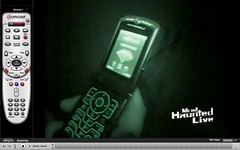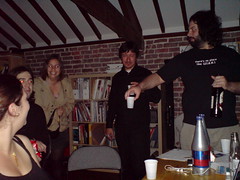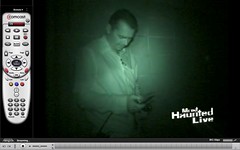Launching US Ghosty
 So we gone dun it. The event I briefly alluded to in a post on Friday happened: we unleashed our Ghost Detector on America!
So we gone dun it. The event I briefly alluded to in a post on Friday happened: we unleashed our Ghost Detector on America!
This was a really really big deal for us, for lots of reasons. We've been working on this project with the guys from Wiretown since way back in 2005, and the detector has been through several incarnations since then: first intended to be launched in the UK on Living TV, then put out by the Horror Channel and sold via their WAP portal, before returning to its roots in the US.
 Ah, the US: Ghosty marks a first for us, the first piece of work we've launched for a US audience. And all things considered, it went very smoothly. We carried out our porting using the incredible MobileComplete, who provide a fantatic service for companies like us: we were able to test, debug and fix a networked application, running in situ on real US handsets, from our offices here in Brighton. Granted, it wasn't quite as pleasant as actually having the phone in our grubby mitts, and doing this stuff over the net can be painfully slow, but it made the impossible possible. Mind you, our Cactus toolkit for doing UI stuff has really helped out here: nice to see it working smoothly onto US handsets.
Ah, the US: Ghosty marks a first for us, the first piece of work we've launched for a US audience. And all things considered, it went very smoothly. We carried out our porting using the incredible MobileComplete, who provide a fantatic service for companies like us: we were able to test, debug and fix a networked application, running in situ on real US handsets, from our offices here in Brighton. Granted, it wasn't quite as pleasant as actually having the phone in our grubby mitts, and doing this stuff over the net can be painfully slow, but it made the impossible possible. Mind you, our Cactus toolkit for doing UI stuff has really helped out here: nice to see it working smoothly onto US handsets.
Other natty technology we got to take for granted: Skype and Slingbox; the former let us IM all through the event (with teams on-set, at Discovery, at Wiretown, at Kargo - the guys who did the associated portal and messaging - and here in Brighton). The latter let us experience the live broadcast, and the dreadful advertising which bracketed it... it really helped us get into the swing of things.
 A few of us had hung around FPHQ for the whole evening in preparation for the event (which kicked off at 1am GMT), doing last-minute stuff, checking and rechecking ports and servers, and throughout the evening most of the guys filtered in, with a hefty crowd of us staying in the office until daylight came. I think it's fair to say that we were all childishly excited at seeing our work on-screen :)
A few of us had hung around FPHQ for the whole evening in preparation for the event (which kicked off at 1am GMT), doing last-minute stuff, checking and rechecking ports and servers, and throughout the evening most of the guys filtered in, with a hefty crowd of us staying in the office until daylight came. I think it's fair to say that we were all childishly excited at seeing our work on-screen :)
And as usual, lurking around this facade of ludicrousness was some fairly serious stuff; if you've met me over the last year there's a good chance I've droned on at you about participation TV. Post-Richard and Judy, we think that broadcasters (and viewers) are (rightfully) nervous about SMS-based interactivity. At the same time, there's room for deeper connections between audiences and programme formats, and the Ghost Detector is an example of this. As well as a standalone application, it gave owners the opportunity to report their name and zip-code into Most Haunted Live!: building a ghostly picture of the US which was cut to at points throughout the programme, and involving everyone in a nationwide ghost-hunt. It's also interesting to note that over 90% of users actively chose to share their identity and location in this way: bit of a mandate from the audience for that kind of stuff, we think. I'll see if I can share more stats here in time...
 Inevitably, we've learned a lot from the experience and there are things we would differently next time (particularly when it comes to managing the whole process from kick-off to go-live). We've also learned a great deal about what actually works in these situations, and what seems to get audiences engaged: lots of insights which we'll draw on next time we're doing one of these events. Drop me a line or leave a comment if you'd like to talk more about this sort of thing.
Inevitably, we've learned a lot from the experience and there are things we would differently next time (particularly when it comes to managing the whole process from kick-off to go-live). We've also learned a great deal about what actually works in these situations, and what seems to get audiences engaged: lots of insights which we'll draw on next time we're doing one of these events. Drop me a line or leave a comment if you'd like to talk more about this sort of thing.
So a big thankyou to everyone who was involved: the team at Discovery, the guys at Wiretown, the geezers and gurus at Kargo, and of course all the folks here at Future Platforms who literally toiled through the night (for the second time!) to bring this madness to fruition.